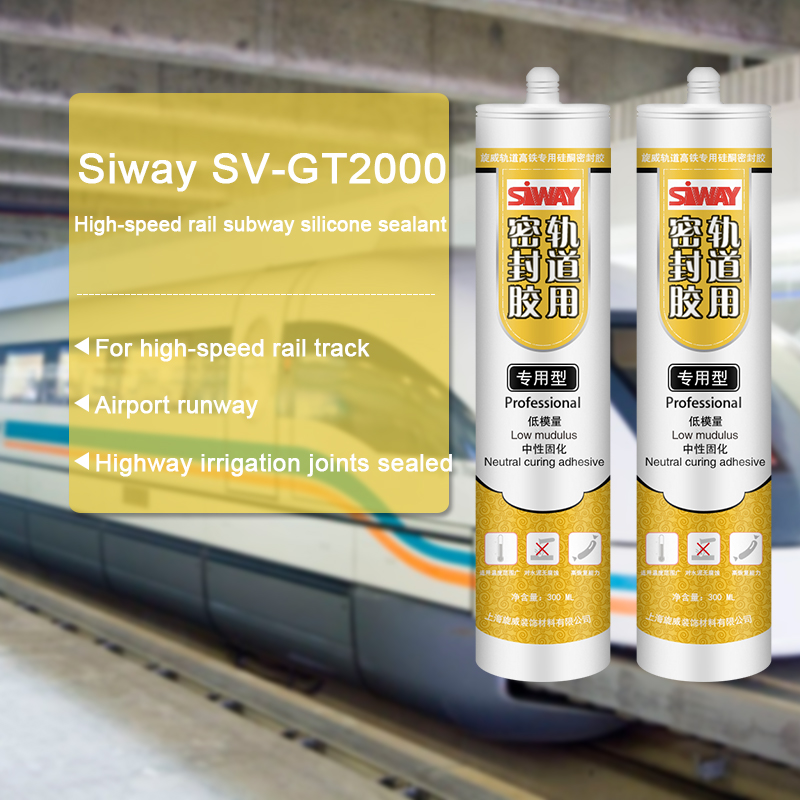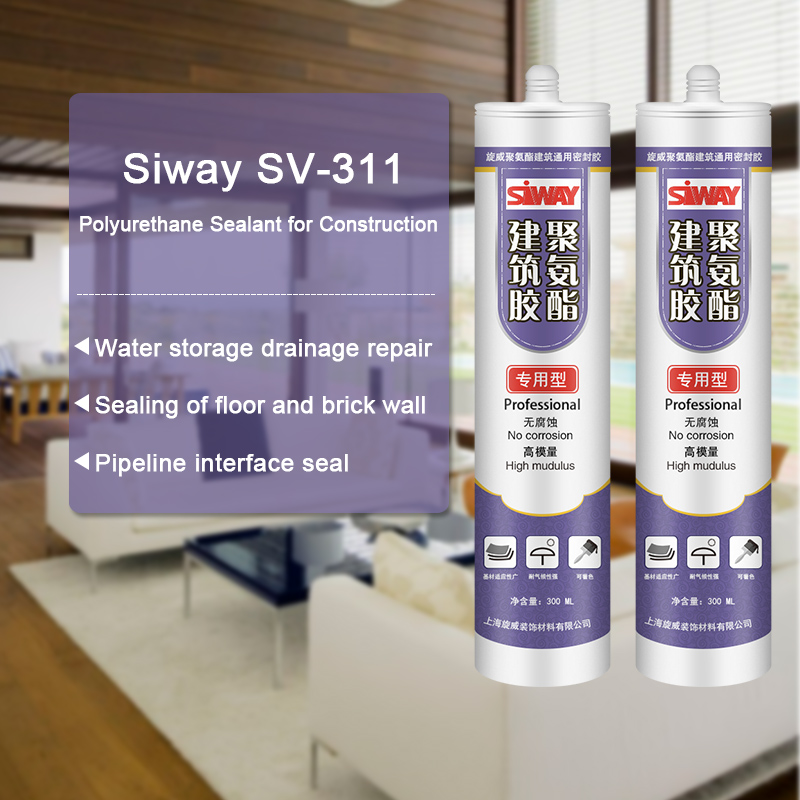13 Years Factory SV-GT2000 High-speed rail subway silicone sealant Export to Czech
Short Description:
Description SV-GT2000 High-speed rail subway silicone sealant is a one-component, low modulus, neutral curing adhesive. For most of the stone, ceramic and cement components, can produce excellent adhesion Key Features (1) easy to use: can be used at any time out; (2) excellent thixotropy and extrusion, at any temperature (-40 ℃ to 100 ℃) can be extruded; (3) good adhesion, the stone, ceramics and cement components and other building materials with excellent adhesion properties; no poll...
"Quality first, Honesty as base, Sincere service and mutual profit" is our idea, in order to develop continuously and pursue the excellence for 13 Years Factory SV-GT2000 High-speed rail subway silicone sealant Export to Czech, Contact with us today! We are ready for the market service now!
Description
SV-GT2000 High-speed rail subway silicone sealant is a one-component, low modulus, neutral curing adhesive. For most of the stone, ceramic and cement components, can produce excellent adhesion
Key Features
(1) easy to use: can be used at any time out;
(2) excellent thixotropy and extrusion, at any temperature (-40 ℃ to 100 ℃) can be extruded;
(3) good adhesion, the stone, ceramics and cement components and other building materials with excellent adhesion properties; no pollution of the porous material;
(4) excellent weather resistance, aging performance, excellent tensile and compression resilience, can carry ± 30% displacement capacity;
(5) neutral curing, stone, cement and other building materials without corrosive, to overcome the shortcomings of acid corrosion material.
(6) base modulus: passive deformation occurs when the role of moderate stress on the concrete substrate to ensure that the concrete surface is not destroyed;
(7) high elasticity high recovery capacity: can be repeated from the seams with the movement, fast response fast response, permanent deformation of small.
Basic Application
1.For high-speed rail track, airport runway, highway irrigation joints sealed, can withstand large displacement;
2.Can also be used for other concrete pavement sealing, subway engineering, tunnels, bridges and other projects sealed.
Technical data sheet
|
Test project |
Unit | value | ||
| surface drying time(25℃,50%R.H.) | min | ≤60 | ||
| Sagging(70℃) | vertical | mm | ≤3 | |
| Horizontal | mm | 0 | ||
| Mass loss rate | / | ≤5% | ||
| Elastic recovery rate | / | ≥80% | ||
| 100% tensile strength | 23℃ | MPa | ≤0.3 | |
| -20℃ | MPa | ≤0.3 | ||
| tensile strength | 23℃ | MPa | ≥1.0 | |
| -20℃ | MPa | ≤2.0 | ||
| 168 h after thermal aging (80 ℃) | MPa | ≥0.8 | ||
| 168 h after alkali treatment | MPa | ≥0.8 | ||
| Breaking elongation | 23℃ | / | ≥800% | |
| -20℃ | / | ≥600% | ||
| 168 h after thermal aging (80 ℃) | / | ≥600% | ||
| 168 h after alkali treatment | / | ≥600% | ||
| Bond strength | 23℃ | / | No damaging | |
| -20℃ | / | No damaging | ||
| 168 h after thermal aging (80 ℃) | / | No damaging | ||
| 96 h after immersion | / | No damaging | ||
Color
Black, White, Gray
Package
300ml in cartridge * 24 per box, 590ml in sausage *20 per box
Shelf life
12 months
Note
If you want the TDS or MSDS or other details, please contact with our sales person.
Get the ultimate DIY book ► https://thekingofdiy.com
Follow me ► https://facebook.com/uarujoey
How to build a plywood aquarium. Sounds fishy right? Building a wooden tank? Have no fear… I will show you how to build a plywood aquarium, while keeping it affordable, simple, LOOK GREAT and what i like to call: Bullet proof.
This is part 1 of a 6 part build. In this video I show you how I built the tank itself. The shell of the tank came first.
Part 2: https://www.youtube.com/watch?v=dS6AJL3CAt0
Does the pressure in your Combi boiler or heating system boiler keep dropping? Here’s how to fix it! We’ll show you why it happens, and how to fix it. We’ll show you how the filling loop works with mains pressure, we’ll show you how the expansion vessel works and can fail, how the high pressure relief valve can release pressure and how a lack of inhibitor can cause air and a drop in pressure.
***VISIT OUR SPONSORS***
https://www.traderadiators.com | https://www.grahamplumbersmerchant.co.uk | https://www.buteline.com/uk | https://www.adey.com
SEE OUR CARDS AND ANNOTATIONS TO FOLLOW ON TWITTER, FACEBOOK AND GOOGLE PLUS!
***WEBSITE***
https://www.plumberparts.co.uk
So you’ve been noticing lately that the pressure gauge on the front of your boiler that looks very similar to some of the pressure gauges that I’ve got going on behind me at the moment has been dropping down. Now if it goes anywhere below kind of half a bar, then you know that you’ve got a problem and obviously if it’s constantly going down all the time or that recently you’re topping it up using a filling loop like then you’ll know that you’ve definitely got a problem. Now there’s a few things that can cause this and inside a heating system, the cold water atoms and On a pressurized system, instead of having the expansion pipe, you have what’s called an expansion vessel. How they work is very simple. It’s very difficult to compress water and so therefore you have an expansion vessel with a rubber diaphragm and on one side of the diaphragm you have compressed air that’s usually compressed to one or one and a half bar and on the other side you have your heating system water. So as that water heats up and expands, it gets more and more happy, it can expand into the easily compressed air without letting air into the heating system because there’s a rubber diaphragm in the way. So make sure that your heating system is nice and full of water at all times, you have a filling loop that fills up the cold water from the cold water main system and make sure that everything’s okay. So now you’ve got a basic idea about how a pressurized heating system works. Let’s look at problem number one that could cause a pressure drop. Firstly and most obviously of all, you could have a leak on your heating system somewhere. When it comes to finding leaks, the best thing to do is pop around all the radiator valves for a start and just make sure there’s no leaks on them. Make sure you lift up the heads as well to make sure that there’s no weep on top of the valves. Make sure that the compression fittings on each side of the radiator valves are nice and tight and there’s no water anywhere. Just go around, run around with your hands and make sure that you’ve got no leaks there at all. That’s number one on the list. Try and stop the leaks. If you find that you can’t find any leaks anywhere, always look out for sort of dark brown patches on the ceiling. They can indicate leaks. After that, you’re into the gnarly world of pulling up floorboards and having a look under the floor. Things like that can get pretty horrible. So that’s number one. You might actually have a leak on your heating system. Number two, most modern combi boilers have what’s called automatic air vents on them. Now they’re great for when it comes to venting a system out. Everything gets vented automatically and it works brilliantly. But they can cause problems if the heating system hasn’t got an adequate amount of inhibitor in it or if the pump setting is set too high for the speed. Let’s go through both of those quickly now. What an inhibitor does is stops the water from reacting with the inside of the radiators and the inside of the components of the heating system itself. If that’s not in there, you’ve got normal water going up against the insides of a radiator and causing horrible things to happen. Many, many months ago I started an experiment with two jars just like this, one with inhibitor in it and one with just water in it and then popped about 10 nails in each and I think you can see the difference. If I just pop these down so you can have a closer look at them, you can see the different state in the nails and if inhibitor is not inside your radiators, that’s exactly what’s gonna happen to the inside. Now, another byproduct of this is not just sludge and rust that goes around and stops a heating system from working properly, it’s also hydrogen and other gases. What happens is the hydrogen can work its way around to an automatic air vent and the automatic air vent’s just doing it’s job, it’s just sitting there having a nice chilled out day, a little bit of gas comes along and it lets it out quite happily, but what happens then is the pressure drops down on your boiler.





